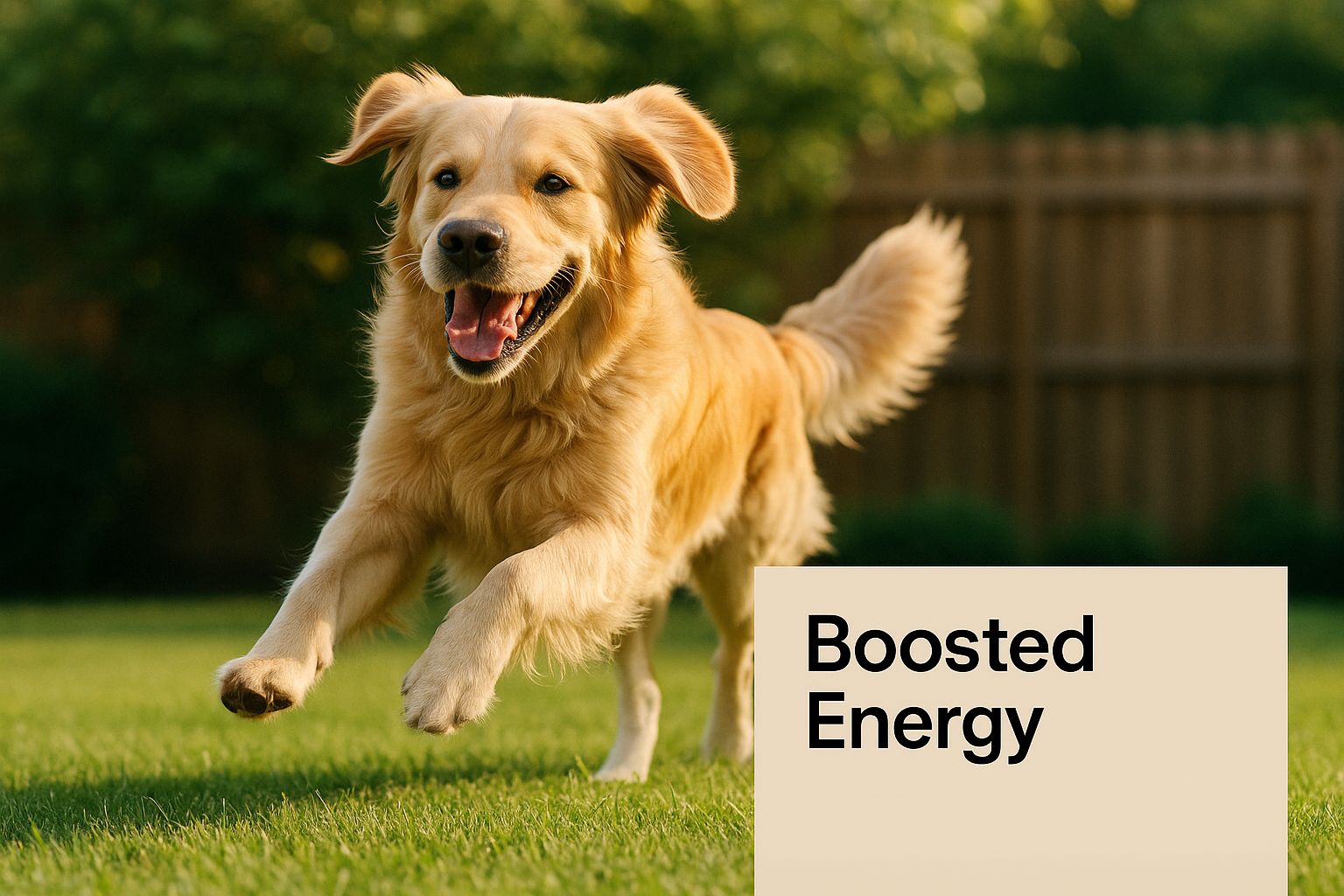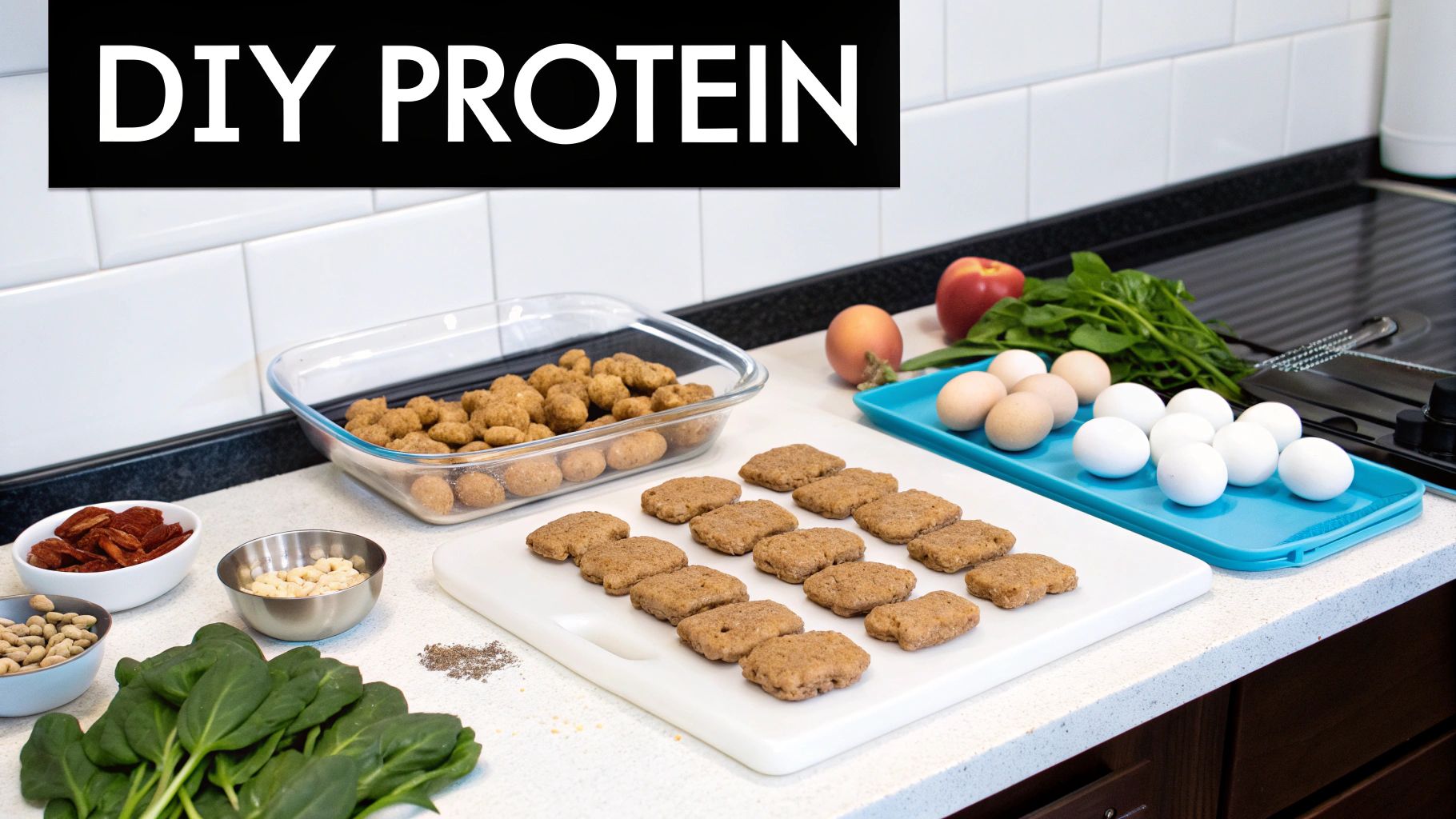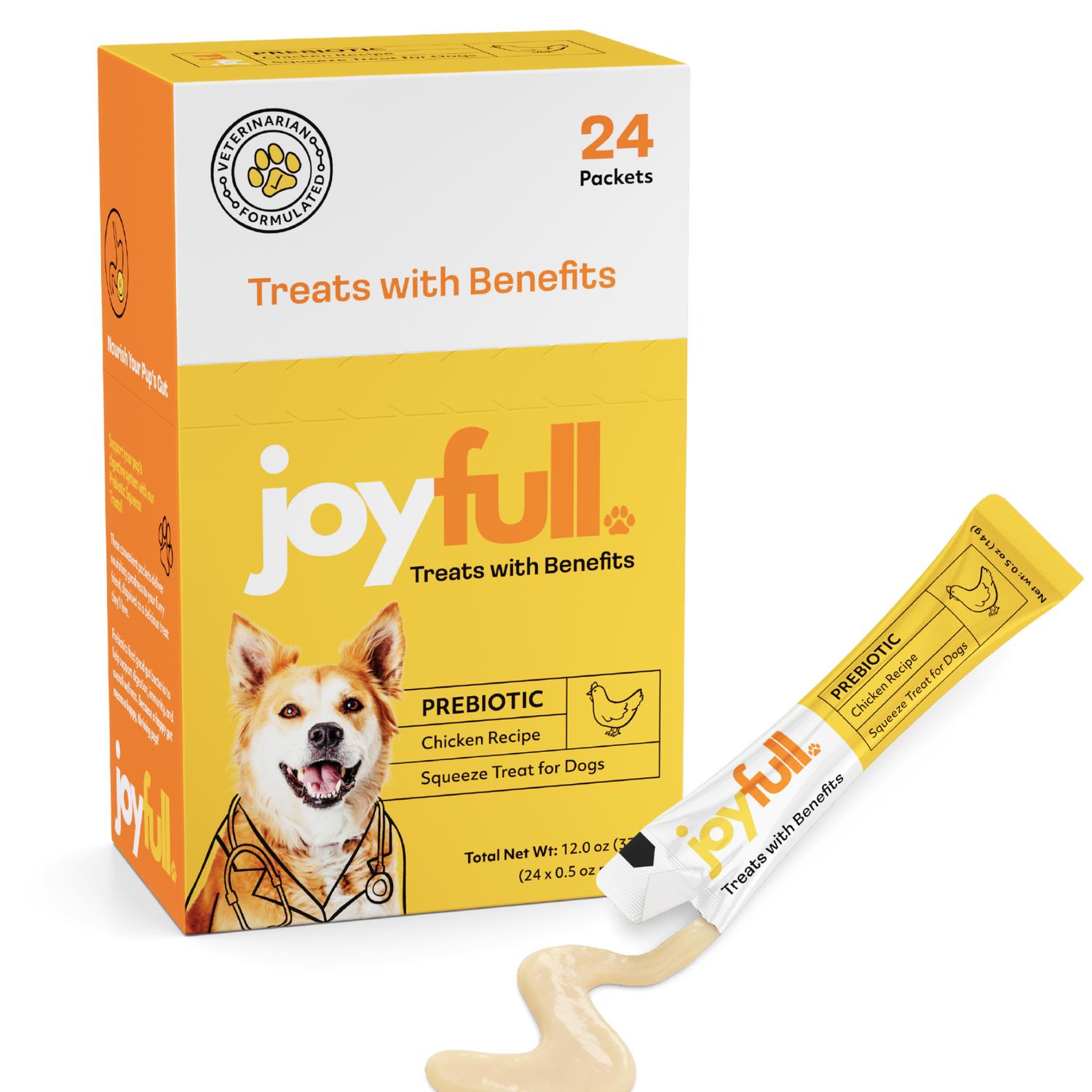
Top High Protein Snacks for Dogs – Healthy & Muscle Support
When we talk about high-protein snacks for dogs, we're not just talking about a simple reward. Think of them as functional fuel, carefully designed to boost your dog's health from the inside out. These snacks pack a punch with a high concentration of animal-based protein, delivering the essential amino acids they need for muscle repair, sustained energy, and vibrant health.
Why Protein Matters in Your Dog's Snacks
It's time to shift our mindset. Snacks aren't just "treats" anymore; they're powerful tools we can use to enhance our dogs' well-being. A high-protein snack works much like a recovery shake for a human athlete, providing the fundamental building blocks their bodies crave to truly thrive.
Imagine high-quality protein as the ultimate toolkit for your dog’s body. Just like a mechanic can't fix a car without the right wrenches and screwdrivers, your dog’s body can't function properly without specific nutrients. The most important tools in this kit are amino acids, the individual components that make up protein.
The Building Blocks of a Healthy Dog
Every time your dog chases a ball, leaps for a toy, or just zooms around the yard, they're creating tiny micro-tears in their muscle fibers. This is totally normal! Protein provides the exact amino acids needed to patch up these muscles, making them stronger than before.
This process is absolutely vital for:
- Active and Working Dogs: These guys are constantly on the move and need a steady supply of protein for muscle maintenance and long-lasting energy.
- Growing Puppies: Their little bodies are in overdrive, building everything from muscles and organs to a strong skeletal frame. Ample protein is a must.
- Senior Dogs: As dogs age, they can lose muscle mass. Extra protein helps counteract this and provides crucial support for their joints. If your older friend is struggling with mobility, you might find our guide on dog treats for arthritis helpful.
It's clear that pet owners are catching on. The global market for high-protein dog food is booming, projected to jump from USD 8.28 billion in 2025 to a massive USD 12.67 billion by 2035. This isn't just a fleeting trend; it’s a major shift in understanding how critical quality nutrition is for our pets. You can see the full market analysis from Future Market Insights for more on this.
The most important thing to remember is this: not all proteins are the same. High-quality, animal-based sources are far more beneficial and bioavailable than cheap, plant-based fillers.
By choosing snacks made with genuinely good protein, you're making a direct investment in your dog’s long-term health and happiness. In the rest of this guide, we'll walk you through how to spot these premium ingredients so you can be confident every treat is making a positive difference.
How to Read a Dog Snack Label Like a Pro
Walking down the pet food aisle can be overwhelming. The shelves are packed with brightly colored bags, all making big promises for your dog's health. But if you want to make the best choice, learning to read the label is the single most powerful skill you can develop. It lets you cut through the marketing fluff and find treats that will genuinely benefit your dog.
Let’s break down what you actually need to pay attention to.
Every package has two critical sections: the Guaranteed Analysis and the ingredient list. The Guaranteed Analysis gives you the basic numbers—the minimum percentage of crude protein and fat, and the maximum percentage of fiber and moisture. It’s a decent starting point, but it doesn't reveal the whole truth about the quality of those ingredients.
Decoding the Ingredient List
This is where the real story is told. Ingredients are always listed by weight, meaning the first few items on the list make up the majority of the snack. When you’re looking for high-protein dog snacks, you want to see a whole meat source right at the top. Look for simple, clear terms like "chicken," "beef," or "salmon"—not vague descriptions like "meat by-products" or "poultry meal."
Think of it like building a house. High-quality, identifiable proteins are the strong bricks that build sturdy muscles and a healthy body. Fillers and mystery meats? They're like cheap plaster. They might fill up space, but they offer zero structural support.
A diet fueled by the right kind of protein is what gives a dog that vibrant, boundless energy we all love to see.

As this picture shows, great nutrition is the foundation for a happy, active dog who’s always ready for the next adventure.
Comparing Common Protein Sources in Dog Snacks
Not all proteins are created equal. Different sources offer unique benefits, and knowing what to look for can help you pick the perfect snack for your dog's specific needs.
| Protein Source | Key Benefits | Best For |
|---|---|---|
| Chicken | Lean, highly digestible, and a great source of amino acids. | Overall muscle maintenance and a popular choice for most dogs. |
| Beef | Rich in iron and zinc, supports energy levels and a healthy immune system. | Active dogs or those needing a boost in red blood cell production. |
| Fish (Salmon, etc.) | Packed with Omega-3 fatty acids for healthy skin, a shiny coat, and joint support. | Dogs with dry skin, dull coats, or those needing anti-inflammatory benefits. |
| Plant-Based Proteins (Lentils, Peas) | Good source of fiber and nutrients; excellent for dogs with poultry or meat allergies. | Dogs with specific food sensitivities or those on a limited-ingredient diet. |
Choosing a snack with a clearly named protein source like the ones above ensures your dog is getting the high-quality building blocks they need to thrive.
What to Look for and What to Avoid
When you're scanning that ingredient list, here are the green flags that signal a top-notch snack:
- Whole Protein First: The #1 ingredient should be something specific and wholesome, like "deboned chicken" or "grass-fed beef."
- Simple, Recognizable Ingredients: The shorter and more understandable the list, the better. If you can't pronounce it, you might want to reconsider it.
- Natural Preservatives: Look for things like mixed tocopherols (which is just a source of Vitamin E) or rosemary extract to keep the snack fresh.
On the flip side, here are some red flags that should make you put the bag back on the shelf:
- Artificial Colors and Flavors: Dyes like "Red 40" or vague flavorings like "animal digest" are completely unnecessary and can trigger allergies.
- Chemical Preservatives: Steer clear of BHA, BHT, and ethoxyquin. These controversial chemicals have been linked to health problems.
- Excessive Fillers: Corn, wheat, and soy are cheap ways to bulk up a treat, but they provide very little nutritional value for most dogs.
True high-protein dog snacks are built on a foundation of quality, not just quantity. A snack with 25% protein from real chicken is far more beneficial than one with 35% protein derived from corn gluten meal and by-products.
At JoyFull, we obsess over this principle. Our formulas always start with clean, high-quality proteins because we believe your dog deserves the best building blocks for a long, happy, and healthy life. By learning to spot these key differences on the label, you can make every single treat a step toward better wellness.
Unlocking Your Dog's Health and Vitality

When you choose a high-protein snack for your dog, you're doing so much more than just rewarding good behavior. It's a real, tangible investment in their long-term health, their energy, and their overall quality of life. The right snack is more than a treat; it’s a powerful supplement that delivers benefits you can actually see, from their get-up-and-go to the shine on their coat.
Think of it this way: your dog's body is in a constant state of building and repairing itself. The amino acids from high-quality protein are the raw materials for almost everything that happens inside them. By giving them plenty of these building blocks through their snacks, you're giving their body the fuel it needs to thrive.
From a Shiny Coat to a Strong Immune System
The perks of a protein-rich diet touch on nearly every aspect of your dog's daily wellness. Sure, everyone knows protein is great for muscles, but the positive effects ripple out much further than that.
Here are a few key areas where high-protein dog snacks really make a difference:
- Healthy Skin and Coat: Did you know a dog's hair is made of about 95% protein? A diet full of quality protein provides the exact components needed for a thick, glossy coat and healthy skin, which can mean less shedding and dryness.
- Robust Immune Function: Antibodies, which are your dog’s little soldiers against illness, are made of protein. Getting enough protein ensures your dog can produce a strong army to fight off infections and stay healthy.
- Lean Body Mass and Weight Management: Protein is crucial for building and maintaining lean muscle, and more muscle means a higher metabolism. This is a game-changer for preventing obesity, a common issue that puts a huge strain on a dog's joints and organs.
It’s no surprise that the global dog snacks market is booming. Pet parents are actively looking for functional treats that do more than just taste good. In fact, projections show the market is set to hit around USD 15 billion by 2025, largely because owners want snacks with real health benefits. You can read more about this growing trend on Archive Market Research.
Real-World Transformations
We see the impact of these snacks firsthand in the stories owners share with us. For an older dog, that extra protein can help fight off age-related muscle loss (a condition called sarcopenia), putting a little spring back in their step and supporting their joints. We’ve heard from so many people who say their senior dogs are suddenly more eager to play and go for walks after making this one simple change.
It's a similar story for highly active dogs. For them, a protein-packed snack is all about recovery after a long hike or a game of fetch. Those amino acids go straight to work repairing muscle tissue, which boosts their stamina for the next adventure.
By incorporating high protein snacks for dogs into their routine, you're not just giving a treat; you're providing a building block for vitality. These snacks are a simple yet effective way to supplement a balanced diet and elevate your dog's overall well-being.
A Practical Guide to Choosing the Right Snacks
Walking down the pet food aisle can feel overwhelming. With walls of colorful bags all promising the best for your dog, how do you cut through the noise and make a choice you feel good about? The good news is, you don’t need a degree in animal nutrition to become an expert at reading a label. It just takes knowing what to look for.
Let's start with the golden rule, the one thing you should never compromise on: a whole meat source must be the first ingredient. Seriously, this is the most important check you can make. Scan the ingredient list for specific, real-food proteins like "chicken," "beef," or "turkey" right at the top. If you see vague terms like "meat meal" or "animal by-products," consider it a red flag for lower-quality stuff.

This simple step ensures the protein in the snack is the good stuff—the kind your dog's body can actually absorb and use to build muscle and stay energized. Think of it as the foundation of a genuinely healthy treat.
Tailor the Snack to Your Dog
Every dog is an individual, right? A snack that's perfect for a hyperactive Border Collie probably isn't the best fit for a senior Pug who prefers napping to fetching. Always think about your dog's specific circumstances when picking out a treat.
Here are a few things to keep in mind:
- Age: Puppies are growing fast and need plenty of protein for healthy development. Older dogs, on the other hand, need it to maintain muscle mass as they age.
- Breed Size: A tiny Yorkie needs a small, easy-to-chew snack to avoid any choking risks, while a Great Dane needs something a bit more substantial to even notice it.
- Activity Level: A dog who spends her weekends hiking mountains or training for agility needs a higher protein boost for muscle recovery than a pup whose biggest workout is the walk to the mailbox.
When you match the snack to your dog’s lifestyle, it stops being just a treat and becomes a valuable part of their diet. This is especially true when you're using treats for training—a high-value reward can make a world of difference. For more on that, you can check out our guide on the best training treats for dogs.
Recognize Beneficial Additions Versus Harmful Fillers
A truly great ingredient list is usually short, sweet, and easy to pronounce. After you’ve confirmed a solid protein source, scan the rest of the list for ingredients that add real nutritional value, not just empty fluff.
Green Flags (What to Look For):
- Fruits and Vegetables: Things like sweet potatoes, carrots, or blueberries are fantastic additions that provide natural vitamins, fiber, and antioxidants.
- Natural Preservatives: Look for mixed tocopherols (which is just a source of Vitamin E) or rosemary extract to keep things fresh.
- Healthy Fats: Ingredients like flaxseed or fish oil provide Omega-3 fatty acids, which are amazing for your dog's skin and coat.
Red Flags (What to Avoid):
- Artificial Preservatives: BHA, BHT, and ethoxyquin are chemical preservatives that have raised health concerns. It’s best to avoid them.
- Cheap Fillers: Corn, wheat, and soy are often used to bulk up treats cheaply. They offer very little nutritional value and are common allergens for dogs.
- Artificial Colors and Flavors: Your dog couldn't care less if their treat is shaped like a bone or colored bright red. These are added for human appeal and can trigger sensitivities.
Choosing the right snack is an act of love. By empowering yourself with this knowledge, you can confidently select high protein snacks for dogs like JoyFull's formulas, knowing they are built with integrity and designed for your dog's optimal well-being.
Matching the Snack to Your Dog's Lifestyle
When it comes to high-protein snacks, there's no single "best" option. The right choice is all about your dog's unique situation—their age, how active they are, and what their day looks like. When you start thinking this way, a simple treat becomes a powerful tool for their health.
Think of it like a human athlete. Their diet changes dramatically depending on whether they're in training season or resting. It’s the same for our dogs. A high-protein snack might be the perfect fuel for one pup but completely unnecessary for another. The real trick is knowing when that extra protein boost will do the most good.
Active Dogs and Post-Activity Recovery
Do you have a dog who lives for adventure? Your hiking partner, agility star, or that one dog who will play fetch until your arm falls off? For them, high-protein snacks are a game-changer for recovery.
Intense exercise creates tiny tears in their muscles. Protein provides the essential amino acids they need to repair that tissue, building it back even stronger and boosting their stamina for the next adventure. Giving them a protein-packed treat after a long run is just like us having a recovery shake after a tough workout. It replenishes their energy and kicks the muscle-repair process into high gear, helping to reduce soreness so they're ready for more fun.
Puppies and Senior Dogs
Puppies and seniors are at opposite ends of the life spectrum, but both have special dietary needs where a little extra protein can make a world of difference.
- Growing Puppies: A puppy's body is basically a construction site. They're rapidly building everything—muscle, bone, and vital organs. High-quality protein is the premium building material they need to grow into a strong, healthy adult.
- Senior Dogs: As dogs get older, they naturally begin to lose muscle mass. This condition, known as sarcopenia, can affect their mobility and overall strength. Supplementing their diet with easily digestible, high-protein snacks helps them hold onto that precious lean muscle.
High-Value Training Rewards
Let’s be honest, during a training session, you need a reward that can cut through distractions and keep your dog focused. High-protein snacks made from real meat are incredibly motivating.
Their rich smell and delicious flavor are often irresistible, making them the perfect tool for teaching a difficult new command or practicing in a busy park.
A high-protein treat isn't just a snack; it's a strategic tool. Whether you're fueling an athlete, building a puppy, supporting a senior, or motivating a learner, you're providing functional nutrition that directly serves a purpose.
This demand for treats that do something is changing the entire pet food landscape. The global market for dog food and snacks is expected to rocket past USD 75 billion by 2025, largely because we see our pets as family and want nutrition that’s tailored to them. This is especially true for working and sporting dogs, who rely on high-protein diets to stay in peak physical shape and remain alert. You can explore more about this market expansion from Petfood Industry.
By matching the snack to the situation, you make sure every single bite counts.
Your Questions About High-Protein Dog Snacks, Answered
Deciding what to feed your dog can feel overwhelming. When it comes to high-protein snacks for dogs, there's a lot of chatter out there—some of it helpful, some of it not so much. Let's cut through the noise and tackle the questions we hear most often from caring pet parents.
We want you to feel confident about the treats you're choosing, so here are some straightforward answers.
How Many High-Protein Snacks Can My Dog Have?
This is probably the most common question we get, and thankfully, it has a simple answer. It all comes down to the 10% rule. No matter how nutritious they are, treats should only make up about 10% of your dog's daily calorie intake. This keeps their main meals as the primary source of balanced nutrition.
So, what does that look like in real life? If your dog's diet is around 500 calories per day, then treats should account for no more than 50 of those calories. Just check the snack's packaging for the calorie count to see how many that is. A couple of potent, protein-rich snacks are usually plenty to deliver benefits without tipping the scales. It’s all about moderation.
Can Too Much Protein Be Harmful to My Dog?
This is a big one—a myth that just won't seem to go away. Many owners worry that high-protein diets will damage their dog's kidneys, but for a healthy, active dog, that's simply not the case. A healthy dog's kidneys are well-equipped to handle the byproducts from digesting protein.
Where you can run into trouble is with calories. The real danger isn't the protein itself, but the risk of weight gain if you're too generous with the treats. Of course, if a dog has been diagnosed with a specific kidney condition, your vet will guide you on a special, protein-restricted diet. But for your average healthy pooch, quality protein is a friend, not a foe.
The bottom line is this: A high-protein diet won't harm a healthy dog. The key is to focus on the quality of that protein and to remember that treats are just that—a treat, meant to be given in moderation.
Are These Snacks Right for Every Dog?
While high-protein snacks are fantastic for most dogs, they aren't a universal fit. The best choice always depends on your dog's unique situation.
- Breed: High-energy breeds like Border Collies and German Shepherds can really use the extra protein to fuel their adventures and maintain their muscle mass.
- Age: Protein is crucial for puppies who are busy building strong muscles, and it's just as important for senior dogs to help preserve the muscle they have.
- Activity Level: Is your dog a weekend warrior who loves hiking, or more of a professional couch potato? The more active they are, the more they'll benefit from protein for recovery.
- Health Status: For any dog with a pre-existing health issue, especially kidney or liver disease, diet needs to be managed carefully. Your vet is your best resource here.
Take a moment to think about your dog’s specific lifestyle. If you want to go a little deeper, our guide on choosing the healthiest treats for dogs can help you narrow down the options. When in doubt, a quick chat with your veterinarian will give you personalized advice you can trust.
At JoyFull, our whole mission is to give pet parents clear, honest options. We craft our formulas with clean ingredients and top-tier proteins to help your dog thrive. Take a look at our snacks at https://joyfullpet.com and find a treat you can feel genuinely good about giving.

